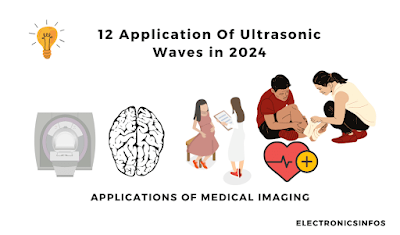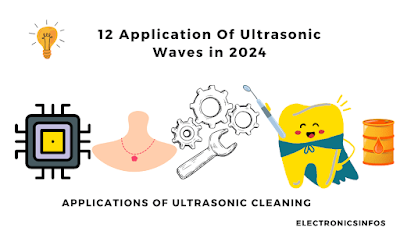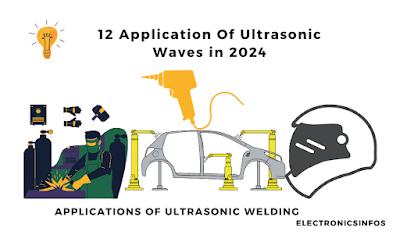Application Of Ultrasonic Waves
What is an Ultrasonic Waves?
ultrasonic waves are sound waves of frequencies above 20,000 c/s.By using a modern method of generation, it has become possible to produce ultrasonic wave vibrations up to frequencies of about 5X10⁵ c/s.The Different Applications of Ultrasonics waves are
Application Of Ultrasonic Waves
- Medical Imaging
- Industrial Testing
- Cleaning
- Welding
- Non-Destructive Testing
- Food Processing
- Sonar
- Ultrasonic Means of Communication
- Determination Of Depth of Sea/Lakes
- Ultrasonic Flaw Detection Methods
- Ultrasonic Surface Waves
- Detection Of Fatigue by Ultrasonic Flaw Detector
Medical Imaging
Ultrasonic waves are widely used in medical imaging, especially in obstetrics and gynaecology. Medical imaging is the use of technology to create visual representations of the interior of the human body.
Ultrasonic waves are used in medical imaging to create images of soft tissues, such as muscles, organs, and blood vessels. This imaging method is known as ultrasound imaging or sonography.
- Ultrasound imaging is used during pregnancy to monitor the growth and development of the fetus.
- Ultrasound imaging can be used to diagnose and monitor various heart conditions.
- Ultrasound imaging is used to examine the organs in the abdomen, including the liver, kidneys, pancreas, and gallbladder.
- Ultrasound imaging is used to diagnose and monitor conditions affecting the muscles, tendons, ligaments, and joints, including arthritis, tendonitis, and sports injuries.
- Ultrasound imaging can be used to diagnose and monitor conditions affecting the blood vessels.
Industrial Testing
Ultrasonic waves are used in industrial testing for non-destructive testing (NDT) of materials. NDT methods involve examining the internal structure of materials. Ultrasonic testing is a popular NDT method that uses high-frequency sound waves to detect flaws in materials.
Applications Of Industrial Testing
- Ultrasonic testing is used to inspect welded joints in pipes, tanks, and other structures.
- Ultrasonic testing is used to inspect aircraft components, such as turbine blades, engine parts, and landing gears.
- Ultrasonic testing is used to inspect automotive components, such as engine blocks, crankshafts, and gears.
- Ultrasonic testing is used to inspect concrete structures, such as bridges and buildings.
- Ultrasonic testing is used to inspect railway tracks and wheels.
- Ultrasonic waves are used to detect the presence of internal cracks, and voids.
Cleaning
Ultrasonic waves are also used in cleaning processes to remove dirt, contaminants, and other particles from surfaces. Ultrasonic cleaning is a popular method in industries such as electronics, jewellery, automotive, medical, and aerospace.
Ultrasonic cleaning works by creating high-frequency sound waves that create tiny bubbles in a cleaning solution.
These bubbles then collapse, producing a cleaning action that removes dirt and contaminants from the surface being cleaned. The bubbles are so small that they can penetrate into small crevices and remove dirt and contaminants.
Applications of ultrasonic cleaning
- Ultrasonic cleaning is used to clean electronic components, such as printed circuit boards, computer chips, and other small parts.
- Ultrasonic cleaning is used to clean jewellery, such as rings, necklaces, and bracelets.
- Ultrasonic cleaning is used to clean automotive parts, such as carburettors, fuel injectors, and engine components.
- Ultrasonic cleaning is used to clean medical instruments, such as surgical instruments, dental tools, and implants, removing blood, and tissue.
- Ultrasonic cleaning is used to clean aerospace components, such as turbine blades and fuel injectors.
Welding
Ultrasonic welding is a process that uses high-frequency ultrasonic vibrations to weld two or more materials together without the need for any additional materials, such as solder or adhesives.
The ultrasonic welding process can be used to join materials such as plastics, metals, and even dissimilar materials.
The ultrasonic welding process works by applying pressure to the materials being welded, while ultrasonic vibrations are applied to the joint area.
The vibrations generate heat that melts the material at the joint, creating a fusion bond. The bond is formed quickly, and the process is energy-efficient, making it a popular method for manufacturing various products.
Applications of ultrasonic welding include
- Ultrasonic welding is used to join plastic components in automotive parts, such as door panels, instrument panels, and lighting assemblies.
- Ultrasonic welding is used to join plastic components in medical devices, such as syringes, IV bags, and surgical instruments.
- Ultrasonic welding is used to join plastic components in electronic devices, such as mobile phones, laptops, and audio equipment.
- Ultrasonic welding is used to join plastic components in packaging materials, such as blister packs and clamshells.
- Ultrasonic welding is used to join textile materials, such as synthetic fabrics, for applications such as garment manufacturing and sealing.
Non-Destructive Testing
Non-destructive testing (NDT) is a technique used to evaluate the properties of a material.
Ultrasonic testing involves the use of a transducer that generates high-frequency sound waves, which are directed into the material being tested.
The sound waves travel through the material and are reflected back to the transducer when they encounter any boundary, such as the opposite surface of the material.
These reflections are then detected by the transducer and converted into an image that shows the internal structure of the material.
Applications of ultrasonic testing in non-destructive testing include
- Ultrasonic testing is used to inspect welded joints in pipes, tanks, and other structures.
- Ultrasonic testing is used to inspect aircraft components, such as turbine blades, engine parts, and landing gears.
- Ultrasonic testing is used to inspect automotive components, such as engine blocks, crankshafts, and gears.
- Ultrasonic testing is used to inspect concrete structures, such as bridges and buildings.
- Ultrasonic testing is used to inspect railway tracks and wheels for any defects that may affect their safety and performance.
Food Processing
Applications of ultrasonic technology in the food processing industry include
- Ultrasonic waves can be used to extract bioactive compounds from various food sources, such as herbs, fruits, and vegetables.
- Ultrasonic cleaning can be used to remove dirt, bacteria, and other contaminants from food processing equipment.
- Ultrasonic waves can be used to preserve food products, such as fruits and vegetables.
- Ultrasonic waves can be used to homogenize and mix food ingredients, such as emulsions, suspensions, and dispersions, improving the texture and appearance of food products.
- Ultrasonic technology can be used to cut and slice food products, such as cheese, fruits, and vegetables.
Sonar
Sonar (Sound Navigation and Ranging) is a technology that uses sound waves to detect and locate objects underwater. Sonar systems generate sound waves that travel through water and bounce back when they encounter an object.
These sound waves are then detected by the sonar system and used to create an image of the object's location, size, and shape.
Sonar technology is used in a variety of applications, including
- Sonar is used to navigate ships and submarines underwater.
- Sonar is used to map the ocean floor and create 3D images of underwater terrain.
- Sonar is used in the fishing industry to locate fish schools, helping fishermen.
- Sonar is used in search and rescue operations to locate objects and people underwater.
- Sonar is used in military applications to detect and locate enemy submarines and underwater mines.
Ultrasonic Means of Communication
Ultrasonic waves are used for sound signalling. The High-Frequency sound waves are readily formed into a beam and sent in the desired
Ultrasonic waves can also be used as a means of communication, both for human-to-human communication and for communication between electronic devices.
Determination Of Depth of Sea/Lake
Ultrasonic technology is used to determine the depth of seas and lakes. The technology works by measuring the time it takes for an ultrasonic signal to travel from the surface of the water to the bottom of the sea or lake and back to the surface again. This time is then used to calculate the depth of the water.
Ultrasonic Flaw Detection Methods
- Contact Method
- Immersion Method
Contact Method
In this method, a transducer is placed in direct contact with the surface of the material being tested. The transducer sends ultrasonic waves into the material, and the waves are reflected back to the transducer when they encounter an internal flaw or defect.
The reflected waves are then converted into electrical signals and displayed on a screen or recorded for analysis.
Immersion Method
In this method, the material being tested is immersed in a liquid that serves as a coupling agent between the transducer and the material. The transducer sends ultrasonic waves through the liquid and into the material, and the waves are reflected back to the transducer when they encounter an internal flaw or defect.
The reflected waves are then converted into electrical signals and displayed on a screen or recorded for analysis.
Conclusion
In summary, ultrasonic waves have a broad spectrum of applications that span across various industries. These applications range from medical diagnostics to industrial uses such as non-destructive testing and cleaning.
In the automotive sector, ultrasonic sensors are crucial for parking assistance systems, and in automation, they enhance process control and monitoring.







.png)



0 Comments
please do not insert spam links